Advanced Tourer Sample¶
AnPyLar includes a more advanced sample which mixes modules, submodules, child routes, whilst building on all the concepts from the Tour of Pyroes tutorial. It is also akin to the more advance routing sample from Angular, to validate the concepts and design choices made when developing AnPyLar
See the sample live: Tourer Sample
Let’s have a look at it
tourer
├── app
│ ├── admin
│ │ ├── __init__.py
│ │ ├── admin_component.py
│ │ ├── admin_dashboard_component.py
│ │ ├── admin_module.py
│ │ ├── manage_disasters_component.py
│ │ └── manage_pyroes_component.py
│ ├── compose_message
│ │ ├── __init__.py
│ │ ├── compose_message_component.html
│ │ └── compose_message_component.py
│ ├── disaster_center
│ │ ├── __init__.py
│ │ ├── disaster_center_component.py
│ │ ├── disaster_center_home_component.py
│ │ ├── disaster_center_module.py
│ │ ├── disaster_detail_component.py
│ │ ├── disaster_list_component.py
│ │ └── disaster_service.py
│ ├── login
│ │ ├── __init__.py
│ │ ├── login_component.py
│ │ └── login_module.py
│ ├── pyroes
│ │ ├── pyro_detail
│ │ │ ├── __init__.py
│ │ │ └── pyro_detail_component.py
│ │ ├── pyroes
│ │ │ ├── __init__.py
│ │ │ └── pyroes_component.py
│ │ ├── __init__.py
│ │ ├── pyro_service.py
│ │ └── pyroes_module.py
│ ├── __init__.py
│ ├── app_component.py
│ ├── app_module.py
│ ├── auth_guard_service.py
│ ├── auth_service.py
│ ├── dialog_service.py
│ └── page_not_found_component.py
├── assets
│ └── app.css
├── anpylar.js
├── index.html
├── package.json
└── styles.css
The key to managing this (more complex than in any of the Tour of Pyroes
samples) structure is in the app_module.py. Let’s have a look at it.
class AppModule(Module):
modules = LoginModule, PyroesModule
components = AppComponent
bindings = {}
services = {
'auth_service': AuthService,
'dialog_service': DialogService,
}
routes = [
{'path': 'compose', 'component': ComposeMessageComponent,
'outlet': 'popup'},
{'path': 'disaster-center', 'load_children': [DisasterCenterModule]},
{'path': 'admin', 'load_children': [AdminModule]},
{'path': '', 'redirect_to': '/superpyroes', 'path_match': 'full'},
{'path': '*', 'component': PageNotFoundComponent},
]
from anpylar import Module
from .app_component import AppComponent
from .compose_message import ComposeMessageComponent
from .page_not_found_component import PageNotFoundComponent
from .admin import AdminModule
from .disaster_center import DisasterCenterModule
from .pyroes import PyroesModule
from .login import LoginModule
from .auth_service import AuthService
from .dialog_service import DialogService
To reduce clutter and show where the complexity is actually managed, we have separated the actual Module class declaration from the imports (which are needed for all the declarations/defininitions inside the class, of course)
Component Bootstrapping¶
components = AppComponent
Even if routes and routes via submodules are in place, if a component is
defined in the components directive for bootstrapping, it will be
instantiated and put in action before the routing engine takes over.
In this case, AppComponent creates the top navigation bar and offers the
main slot for route rendering by providing a <router-outlet> tag.
class AppComponent(Component):
stylepath = None
htmlsheet = '''
<h1 class="title">AnPyLar Tourer</h1>
<nav>
<a routerLink="/disaster-center" routerLinkActive="active">Disaster Center</a>
<a routerLink="/superpyroes" routerLinkActive="active">Pyroes</a>
<a routerLink="/admin" routerLinkActive="active">Admin</a>
<a routerLink="/login" routerLinkActive="active">Login</a>
<a routerLink="/compose" routerLinkActive="active">Contact</a>
</nav>
<router-outlet></router-outlet>
<router-outlet name="popup"></router-outlet>
'''
Notice that:
There are no accompanying
.htmland.cssfiles.The html content is in the
htmlsheetdirective andstylepath = Noneindicates that there is no specific private style for this component.Note
This same development pattern is repeated in this sample for components, in which html and css are embedded in the Python code
Loading submodules¶
Submodules via modules¶
With the modules directive
class AppModule(Module):
...
modules = LoginModule, PyroesModule
...
By declaring both LoginModule and PyroesModule as submodules of our
module, the following will happen.
Any
routesdeclared inside those modules will become part of the route hierarchy defined in our main module
Let’s see the routes in those two modules
class LoginModule(Module):
routes = [
{'path': 'login', 'component': LoginComponent}
]
class PyroesModule(Module):
...
routes = [
{'path': 'pyroes', 'redirect_to': '/superpyroes'},
{'path': 'superpyroes', 'component': PyroesComponent},
{
'path': 'pyro',
'redirect_to': '/superpyro'},
{
'path': 'superpyro',
'params': {'pyd': int},
'component': PyroDetailComponent,
}
]
Submodules via routes¶
class AppModule(Module):
routes = [
...
{'path': 'disaster-center', 'load_children': [DisasterCenterModule]},
{'path': 'admin', 'load_children': [AdminModule]},
...
Using load_children, routes from the Module classes provided are loaded
and added to the routing hierarchy.
The corresponding routes.
class DisasterCenterModule(Module):
...
routes = [{
'path': '',
'component': DisasterCenterComponent,
'children': [
{
'path': '',
'component': DisasterListComponent,
'children': [
{
'path': '',
'component': DisasterDetailComponent,
'params': {'did': int}, # transformation function
},
{
'path': '',
'component': DisasterCenterHomeComponent,
}
]
}
]
}]
class AdminModule(Module):
routes = [{
'path': '',
'component': AdminComponent,
'can_activate': AuthGuard,
'children': [{
'path': '',
'children': [
{'path': 'disasters', 'component': ManageDisastersComponent},
{'path': 'pyroes', 'component': ManagePyroesComponent},
{'path': '', 'component': AdminDashboardComponent}
]
}]
}]
In both cases the routing hierarchy is further extended by:
Using
children, which is again an iterable or route definitions (just like the mainroutesdirective in which it is embedded)
Both do also show:
How empty paths can be used to add Component instances to the hierarchy, but which do not contribute to path matching
This can be, for example, used to have components which add some initial rendering or provide some joint functionality, which could be a service shared by all underlying components.
An excerpt.
...
'children': [
{
'path': '',
'component': DisasterListComponent,
'children': [
{
'path': '',
'component': DisasterDetailComponent,
'params': {'did': int}, # transformation function
},
...
Guards¶
Activation¶
The sample also shows in the routes definition, how a component can be guarded
from activation. A number of reasons may exist for it. In the example a login
is implemented if the user is not yet logged in and access to the Admin
part of the sample.
Guarding the route is implemented with a subclass of AuthGuard, which
provides a service, which has to be started in a services directive.
The location in our layout
tourer
├── app
│ ├── ...
│ ├── auth_guard_service.py
│ ├── auth_service.py
│ ├── ...
├── ...
We have left auth_service.py there because it is the service which our
AuthGuard uses to check for the login status and to long in.
And the declaration in the routes directive of AdminModule.
class AdminModule(Module):
routes = [{
'path': '',
'component': AdminComponent,
'can_activate': AuthGuard,
...
}]
Implementing our AuthGuard is achieved by subclassing the AuthGuard
class in AnPyLar and then overriding the can_activate method.
from anpylar import AuthGuard
class AuthGuard(AuthGuard):
def can_activate(self, route):
return self.check_login(route.path)
def check_login(self, path):
if self.auth_service.is_logged:
return True
self.auth_service.redir_path = path
self.router.route_to('/login', session_id=1234567890)
return False
In the sample the work is delegated to the check_login method, which uses
the auth_service (as explained above) to check for the login status.
Deactivation¶
The sample also adds a deactivation control. This function is delegated in AnPyLar to a Component instance. The rationale: the instance knows if there may, for example, be something pending which should prevent navigating away.
In the sample this is implemented in the detail editing part of the Disaster Center.
class DisasterDetailComponent(Component):
htmlsheet = '''
...
<button (click)="router.route_to('')">Cancel</button>
...
'''
...
def can_deactivate(self):
if not self.edit_did or self.selected.name == self.edit_name:
return True
# dialog_service is in the main module
return self.dialog_service.confirm('Discard changes?')
The snippet shows the relevant parts of the code
The Cancel button which creates a binding to
router.route_to('')when pressed.This
''route might seem a nonsense, but remember (as seen above) that we have a hierarchy of routes with{'path': '' ...}, i.e.: routes that add no path but instantiate componentes.That why routing to
''makes sense: we are routing within the same hierarchy. In this particular case we know the routing engine won’t select theDisasterDetailComponentbecause no parameter is passed (which is the tie breaker for our hierarchy with no path additions)
Because router.route_to('') would be navigating away from our actual
component, the routing engine checks the active component,
DisasterDetailComponent, to see if this is possible by invoking can_deactivate.
can_deactivatechecks if actual editing has taken place and if so, it will use thedialog_serviceto request confirmation.
dialog_servicestarts an asynchronous operation which is returned as an Observable which is further returned to the the caller (the internal engine)Any value returned by
can_deactivatewhich is not an Observable (likeTruein the snippet above) will be internally turned into an Observable with theofoperator, for consistency, keeping the operation asynchronous and thus not blocking the user interface.
Not Found¶
In case a link is not found, the routing engine offers the possibility to define a last resort route (or catch-all) which works as the usual Not Found pages.
The definition is in the main routes directive in AppModule.
class AppModule(Module):
...
routes = [
...
{'path': '*', 'component': PageNotFoundComponent},
]
By specifying 'path': '*' (or ** if wished) this will be the last
resort route. To test it the sample offers a Save the World button in the
PyroesComponent which routes to /save-the-world
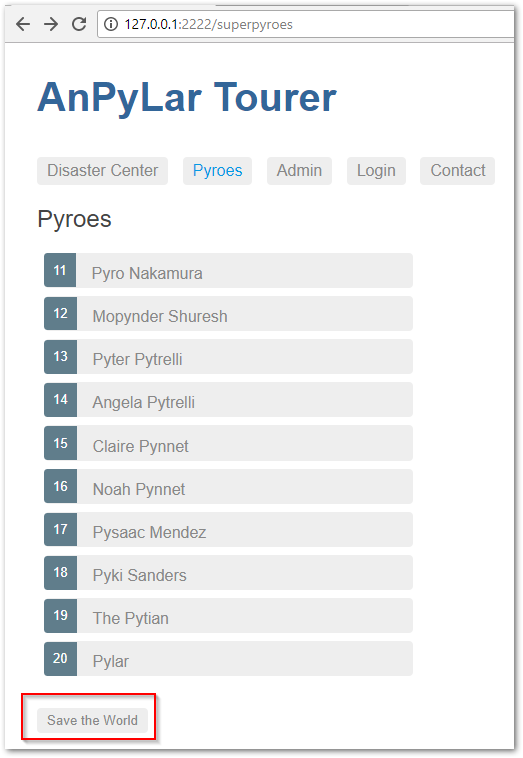
When the button is clicked, the routing engine takes the application to the
PageNotFoundComponent, which in this case is really simple.
class PageNotFoundComponent(Component):
htmlsheet = '''
<h2>Page not found</h2>
'''
Producing the following result on-screen.
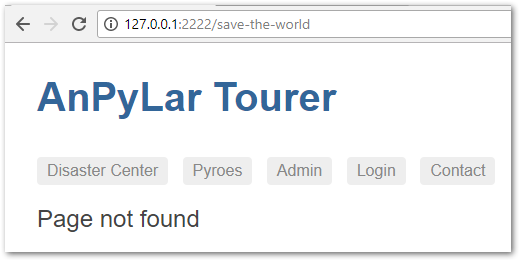
Named Outlet Routing¶
In addition to the regular routing to the <router-outlet> tag, named outlet
routing is also possible. This functionality is used in the sample to show a
contact dialog, which travels across paths in the independent named
outlet.
The declaration is made in the main component of our application:
AppComponent. Recalling the contents of app_component.py.
class AppComponent(Component):
htmlsheet = '''
<h1 class="title">AnPyLar Tourer</h1>
<nav>
<a routerLink="/disaster-center" routerLinkActive="active">Disaster Center</a>
<a routerLink="/superpyroes" routerLinkActive="active">Pyroes</a>
<a routerLink="/admin" routerLinkActive="active">Admin</a>
<a routerLink="/login" routerLinkActive="active">Login</a>
<a routerLink="/compose" routerLinkActive="active">Contact</a>
</nav>
<router-outlet></router-outlet>
<router-outlet name="popup"></router-outlet>
'''
stylepath = None
Where we can see the syntax:
<router-outlet name="popup"></router-outlet>
The named outlet has a corresponding entry in the routes of AppModule:
{'path': 'compose', 'component': ComposeMessageComponent,
'outlet': 'popup'},
which translates to:
For
'path': 'compose''Instantiate
ComposeMessageComponentAnd place it under:
<router-outlet name="popup"></router-outlet>
If we see our application at the Disaster Center (resizing the app to fit the view of the developer tools)
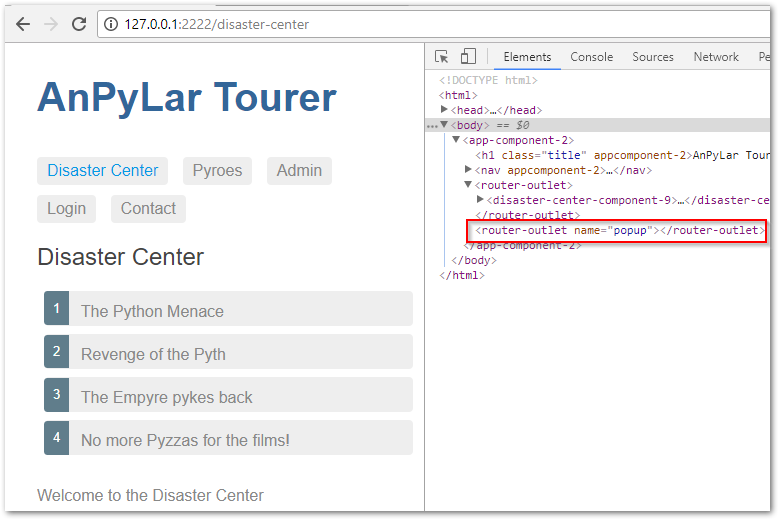
In the Elements box, the named outlet tag has been highlighted. Clicking on
Contact produces the following.
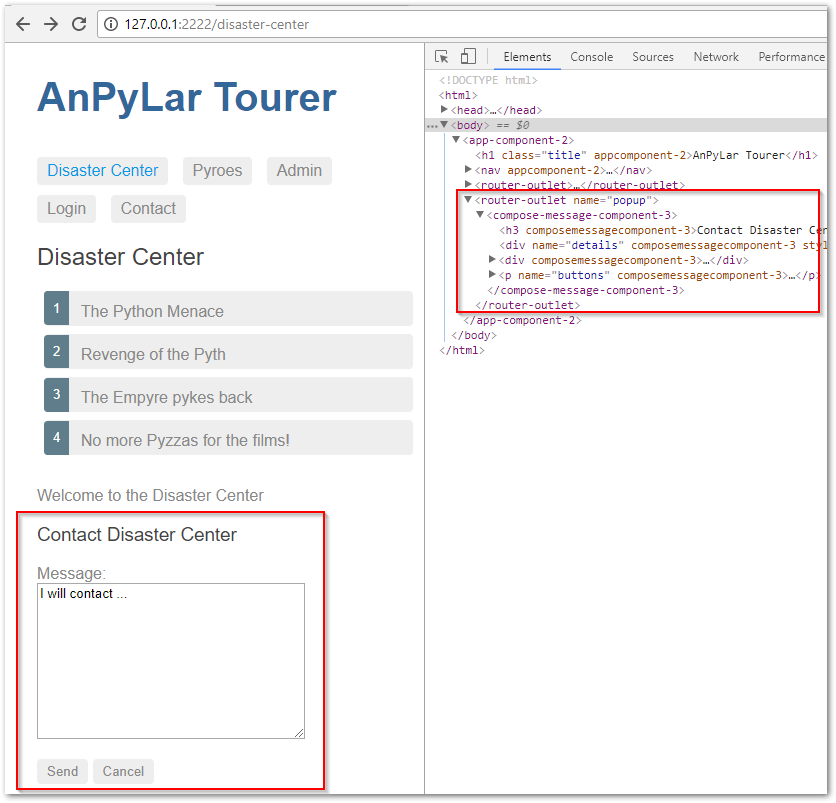
Without disturbing the main view in <router-outlet>, the contact form has
been displayed inside <router-outlet name="popup">. Moving to a different
part of the application carries across the open form (we have added a message
before moving away to show how the component remains unaltered)
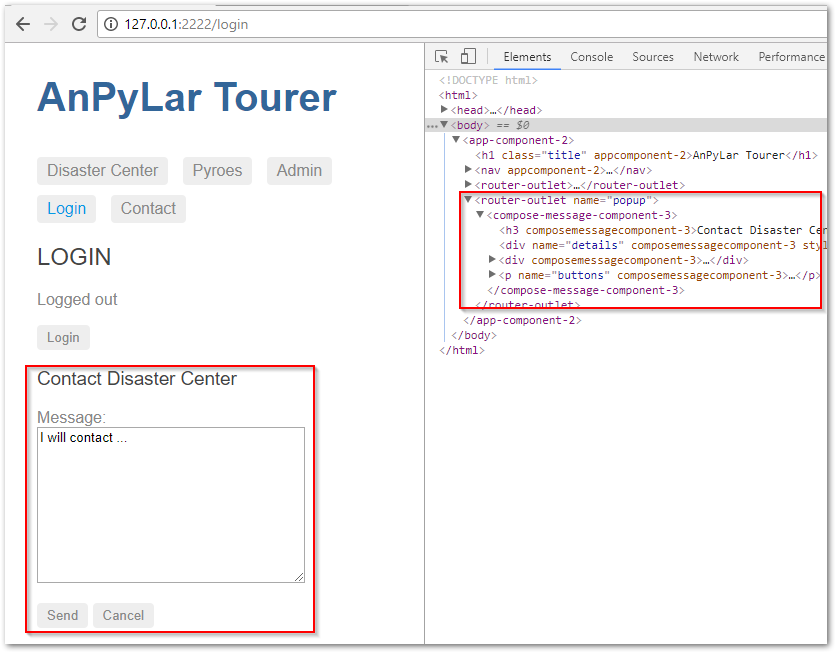
As shown a named outlet is not meant to be closed by navigating away from the
route, because it has not changed the path and is transparently carried over,
we need to be specific about how to close the outlet. Let’s see the code for
the ComposeMessageComponent
class ComposeMessageComponent(Component):
bindings = {
'details': '',
'msg': '',
}
def unloading(self):
# return to default state when unloading for next load
self.details = ''
self.msg = ''
def render(self, node):
d = node.select('div[name="details"]') # will get first
d._display(bool(self.details_))
d._fmt(details=self.details_)
t = node.select('textarea')._fmtvalue(self.msg_)
p = node.select('p[name="buttons"]')
p._display(self.details_ == '')
bsend = node.select('button[name="send"]')
bsend._bindx.click(self.send)
bcancel = node.select('button[name="cancel"]')
bcancel._bindx.click(self.close_popup)
def send(self):
self.details = 'Sending Message ...'
# the message would be available in self.msg
Observable.of(True) \
.delay(2000) \
.subscribe(self.close_popup)
def close_popup(self, close=True):
self.close_outlet()
Nothing should be groundbreaking except the last method: close_popup, which
is for example used after sending (is added as a subscription to the
Observable) and invokes:
self.close_outlet()
I.e.: a Component instance has a specific method which allows closing the named outlet in which it is being displayed.
Conclusion¶
The rest of the functionalities in the sample build on the concepts from the
Tour of Pyroes tutorial and do simply offer variations of file layout, like
in the disaster_center module.
tourer
├── app
│ ├── ...
│ ├── disaster_center
│ │ ├── __init__.py
│ │ ├── disaster_center_component.py
│ │ ├── disaster_center_home_component.py
│ │ ├── disaster_center_module.py
│ │ ├── disaster_detail_component.py
│ │ ├── disaster_list_component.py
│ │ └── disaster_service.py
│ ├── ...
├── ...
└── styles.css
Here and instead of having the different components in subdirectories, the usual pattern in the Tour of Pyroes, all components are in the same directory with the module.
Because the components have the html code embedded in htmlsheets directives
in the Python code, this may be a convenient layout, as there are no separate
.html files (and this case neither .css files)
Have a look and play with the elements.